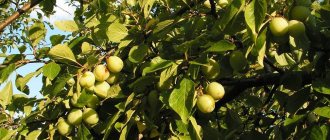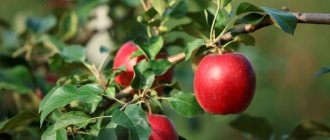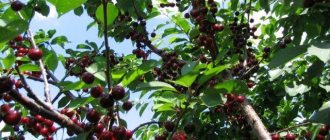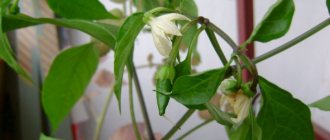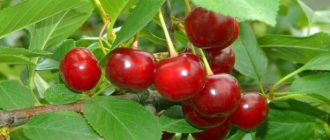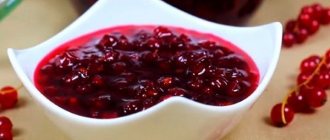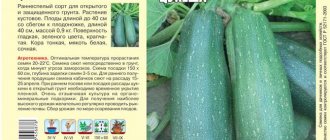The miracle cherry or duke variety (prunus cerasus “chudo vishnya”) is a wonderful hybrid of cherries and sweet cherries, which was bred at the Donetsk Horticultural Research Station in Artemovsk by crossing varieties:
- Griot Ostheim cherries;
- cherries Valery Chkalov.
The creators of this cherry hybrid are L.I. Taranenko. and Sychova A.I.
Description of the miracle cherry variety, photos, reviews, features of care and choice of pollinators - this information will help gardeners deepen their knowledge of the hybrid and decide whether to grow it on their site or not.
Cherry Miracle: description, distinctive features
Miracle is a fruit tree that looks similar to both cherries and sweet cherries. It reaches a maximum of 5 meters in height, its crown resembles an ordinary cherry, but at the same time it is quite branched, like a cherry. The tree grows intensively for the first two to three years, and when it enters the fruiting period, it switches to a moderate growth rate.
With proper care, the Miracle cherry quickly grows and blooms actively
The average harvest size from one tree can reach 15 kg. The fruit ripening period begins at the end of June or at the beginning of July (depending on the region and weather conditions). The berries are collected in clusters of 6–7 pieces, each weighing 10 g. Ripe fruits have a dark red color, characteristic of cherries.
Ripe berries are more similar to cherries due to their rich dark red hue and sweet taste.
A distinctive feature of the Miracle variety is the size of the flowers: they are larger than those of cherries, although they are identical in appearance. The leaves of the hybrid are also larger than those of the mother varieties, there is no pubescence, and they are oval in shape, with a pointed apex. The berries are devoid of sourness and have a dessert taste. The skin is dense, and the seed is easily separated from the juicy pulp.
The Miracle variety, like many other dukes (cherry-cherry hybrids), might not have existed. Duke was produced by accidental pollination of cherries and sweet cherries and for a long time was not of interest to gardeners, as it bore fruit poorly and could hardly tolerate the cold. However, breeders managed to ensure that this hybrid began to demonstrate high yields and frost resistance.
The main benefits of Cherry Miracle
- Disease resistance. Moniliosis, coccomycosis and other diseases characteristic of cherries practically do not affect Miracle. Very rarely, the plant is also affected by the cherry fly - with proper care, its appearance is excluded.
- Fruit. Miracle has excellent taste and high quality; they are used both in cooking (preparing compotes, jams and dried fruits) and in folk medicine (a decoction of the stalks is used as a diuretic, and the berries are recommended for use by those who have suffered a heart attack or stroke).
- Early fruiting. For Miracle cherries, this period begins relatively early - already at 3–4 years. And with proper tree care, the harvest is generous and of high quality.
During the period of fruit ripening, cherry branches are bursting with berries.
Disadvantages of the variety
- Average level of bud resistance to frost. A sudden cold snap can destroy the buds and ruin the entire harvest. Therefore, if the weather forecast indicates return frosts, one of the ways to protect the tree should be used - sprinkling or covering with improvised materials.
- The crown needs regular care. During active growth, the branches will try to stretch upward, and they must be directed to a horizontal position. This can be done in two ways: hanging weights or tying branches to the tree trunk.
Cherry branches need to be given a horizontal position
Sprinkling is spraying the crown with a sprayer or hose; protects the kidneys due to the fact that when water freezes, it begins to release heat, which saves the future crop from death.
Advantages and disadvantages of the variety
Advantages:
- good winter hardiness;
- high resistance to fungal diseases;
- early fruiting (the first few fruits appear on a 2-year-old tree, active fruiting from 4 years);
- high (10–15 kg per tree) and regular yield;
- beautiful appearance and high taste of berries.
Flaws
- self-sterility;
- instability to severe frosts, especially flower buds.
Step-by-step process of planting Miracle cherries
- On the day of planting, a hole dug in advance is fertilized with the same substances as the site in the fall, only 10 kg of organic fertilizer is taken, phosphorus - 300 g, potassium - 80 g. Instead of potassium, the use of ash is allowed.
- Soil 50 cm high is poured into the center of the hole, and a seedling is placed on it. The roots must be spread over the entire area, covered with the remaining soil on top and compacted.
- When watering, a hole is formed around the plant so that the water does not spread. For one cherry, 20–23 liters of water is enough.
- The watered soil is sprinkled with earth, the tree is tied to a support so that the wind does not swing it and break it.
Landing Features
The cherry orchard will delight you with an abundance of fruits for many years, if you take into account all the factors necessary for the growth and development of the crop.
Cherries should be placed in elevated places, illuminated by the sun most of the day. Damp lowlands where water stagnates after rains are not suitable. And also, areas with close groundwater levels - excess moisture is detrimental to the tree. Plants should be planted close to a fence, hedge or building to protect them from the wind. Cherry loves a warm microclimate.
The tree prefers to grow on sandy soil that is water- and breathable. It develops and bears fruit poorly on sandy, heavy clay soil with a high level of acidity. Acidic soils are alkalized by adding lime (500 g/1 m2).
Trees should be planted at a distance of 5 m - they grow quickly, needing a large feeding area.
In temperate climates, the best time for planting is early spring, when the temperature is above zero. In the southern regions, the crop can be planted in the fall. All September to mid-October - 2-3 weeks before frost, the seedlings will have time to take root. Container plants can be planted all season long.
Selection of seedlings
You should not purchase seedlings at spontaneous markets: there is a risk of buying a diseased plant or the wrong variety. In specialized stores, a tag is attached to each plant indicating the age of the tree, varietal, and pollinator. The seedling should be selected grafted. The grafting site can be determined by a slight thickening and curvature of the trunk 10 cm from the root collar.
2-3 year old plants take root best. A healthy seedling must have a straight trunk, at least 5 flexible shoots, strong roots without signs of rot (at least 20 cm long).
It is advisable to purchase container plants that are planted together with the ground, so their survival rate is better.
The best planting material is usually offered at the end of the season. Then it’s too late to plant cherries, so they are buried in the garden until spring. It is necessary to place the seedlings in trenches at an angle with their crowns facing south, cover them with earth and cover them with spruce branches.
Landing
3 weeks before planting (or in the fall, if planting is in spring), dig planting holes 60x80 cm, with a distance of 5 m between them. Add 10 kg of humus, 150 g of double superphosphate, 50 g of potassium sulfate or 400 g of ash to the fertile layer of soil . A bucket of sand is added to clay areas, sandy soil is improved with humus and peat (bucket/1 m2). Before planting, you should keep the roots of the seedling for 2 hours in a solution of growth stimulants - Kornevin, Heteroauxin.
Step by step process:
- A portion of fertile soil is poured into the hole in the form of a mound.
- The plant is lowered onto it, spreading the roots in different directions. The container seedling is placed in the planting hole along with a lump of earth.
- Install a peg on the side. Cover the tree, shaking it slightly so that the soil fills all the spaces between the roots.
- The root collar is not buried - it should be 5 cm above ground level.
When planting, the seedling is not buried; the root collar should be 5 cm above the soil level
- The seedling is loosely tied to the support so that the fragile tree does not sway from the wind.
- Compact the earth and form a circular hole into which 2 buckets of water are added.
- After moisture is absorbed, the soil is mulched with straw. A layer of mulch 10 cm thick retains moisture near the roots and prevents weeds from growing.
Mulch retains moisture in the soil and prevents weeds from growing
- After spring planting, the seedling is shortened by 1/3 to reduce the amount of moisture evaporated by the crown and not cause the plant to dry out. In autumn, pruning is not done, but is postponed to the beginning of the next season.
Rules of care
So that all efforts to plant cherries are not in vain, you need to pay attention to each mandatory element of proper care: watering, fertilizing, pruning and protecting the tree from frost.
Watering recommendations
For the first few months, watering the cherries should be plentiful - about 15 liters per tree weekly. After the seedling has grown stronger, irrigation procedures can be carried out once every 2 weeks, depending on the weather. After 6 months, watering should be reduced to 4 times a year: after the end of the flowering period (late May), during shoot growth (June), in dry weather in the summer and before the start of winter (October) at the rate of 6-7 buckets of liquid per tree. You should dig a circle 20 cm deep around the trunk of the cherry tree and pour water into it. This will give the roots the amount of moisture they need.
Water should be poured into a trunk circle formed around the tree
Cherry feeding
For the first 5 years, you don’t even have to think about fertilizing cherries. This is especially true for nitrogen fertilizers: they significantly accelerate the growth of the trunk, while the root remains the same. As a result, the amount of harvest decreases. After 5 years, the tree is fertilized in the period July-September with superphosphate and potassium sulfate in the amount of 350 g and 150 g, and in early spring (mid-late March) humus, compost or manure is added at the rate of 20 kg per cherry.
Formative and sanitary pruning
Every year the cherry tree will need to be pruned. The best time for this is mid-spring. However, more than 25% of the shoots cannot be removed.
Immediately after planting, pruning is necessary to form the correct crown so that a balance is maintained between the above and underground parts of the tree. , is ideal . Before starting the pruning process, several skeletal branches are selected; they must be at least 50 cm in height. Of these, one is selected to be the central conductor. If the shoots are too long and thin, then they can be trimmed by 10 cm. Also pay attention to the angle at which the branches extend from the trunk: if it is less than 20°, such shoots are cut into a ring immediately, otherwise they will break under the weight of the fruit.
Cherry trees must be pruned immediately after planting and every year in the spring.
Sanitary pruning is carried out every year in early spring to remove branches that grow inside the crown, intertwine with each other, or have become dry. Depending on the condition, they can be shortened by 5–10 cm.
Video: pruning cherries in spring
Experienced gardeners recommend rationing the harvest - this is a procedure typical for the first year after planting. It consists in the fact that 80% of the flowers and 50% of the green berries are picked so that the fruits are larger and sweeter.
Danger of frost
For Miracle cherries, freezing poses a serious danger, since its buds are not frost-resistant. One of the ways to protect them from the cold is smoking: fires are lit near the cherries using peat and straw manure. The resulting smoke will give the plant the necessary heat. This procedure should end no earlier than 2 hours after sunrise.
Pests and diseases of cherries
Cherry Miracle is rarely affected by diseases such as coccomycosis and moniliosis. But bacterial cancer and milky sheen cannot be ruled out. The most dangerous pests are aphids and cherry flies.
Table: cherry diseases and their treatment
| Name of the disease | Signs of defeat | Treatment methods |
| Root bacterial cancer | The appearance of growths on the roots and root collar, slowing down the growth of the tree. Affected seedlings may die. The disease is more pronounced during drought and on alkaline soils. |
|
| milky shine | The fungus causes the leaves to turn lead-white and the wood to brown. When wood is damaged, the branches dry out and the entire tree may die. |
|
Cherry diseases in the photo
Root bacterial cancer manifests itself in the formation of growths on the roots. Growths can occur not only on the roots, but also on the root collar
The fungus that causes milky shine penetrates the wood, leading to its death
Table: cherry pests and protection against them
| Pest name | Signs of defeat | Fighting methods |
| Aphid | Whole colonies of insects settle on the shoots, sucking the juice from them and leaves, causing them to dry out and fall off. | Spray with Karbofos 1%. |
| cherry fly | The fly larvae burrow into the fruit, eat its pulp and excrete excrement, causing the pulp to become a mushy mass. Affected fruits become dark, rot and fall off. |
|
| Cherry slimy sawfly | Shiny green-black moth caterpillars scrape off the green pulp of leaves. In case of severe infection, only dry skin remains from the leaf. |
|
Cherry pests in the photo
Insects literally cover the leaves
The cherry fly larva damages the fruits. The sawfly can leave the tree without leaves.
History of appearance
One of the most popular varieties of cherries can be called the Duke variety or the so-called “miracle cherry”. If literally translated from English, the name of this cherry variety will sound like “May Duke”. This species was obtained by the Ukrainian breeder Lilia Taranenko, who crossed the berries of the “Valery Chkalov” cherry and the “Griot” variety of cherries.
A peculiarity of planting young seedlings of the Miracle cherry variety is that the root collars are placed above the soil surface. Otherwise, improper planting may lead to the death of the tree.
Botanical description of the variety
Hybrid seedlings resemble cherries in their appearance. But, as it grows, it is clear that the adult specimen has average growth strength and has a tree-like type. The structural features of the branches resemble cherries. If you do not trim the top and do not cut out some of the branches, then the shape of the growing tree will be pyramidal. The branches are located at an angle of 45° to the trunk. But they get more harvest on horizontal branches, so it is recommended to use gravity to tilt them towards the ground.
The leaf blades, like those of cherries, are large. The shoots are smooth. The main positive feature of cherries is the formation of buds on the current year's growth. A negative feature is that at -15° freezing of flower buds is observed. Therefore, the variety is zoned for the southern regions of Russia, since harvests north of the Rostov region will not be stable due to the cold winter.
Blooms early as soon as warm spring weather sets in.
Photo of the miracle cherry:
Description of the miracle cherry variety in the video:
Collection, storage and use of crops
The berries begin to ripen in the second half of June. Depending on the purpose, cherries can be picked when they reach full ripeness (for fresh consumption), 3–5 days before ripeness (for canning), or 5–7 days before ripeness (for transportation).
Place the harvested crop carefully so that the stalks do not damage the berries.
Remove the berries with care so that they do not come off the stem. In this case, the pulp is damaged and juice is released. Such fruits cannot be stored. When picking fruits that are not fully ripened, they can be separated along with the fruit, and this injures the fruit formations, causing a decrease in the future yield. When picking berries, it is best to use sharp scissors, cutting the berry from 2/3 of the stalk.
Cherries make delicious and aromatic jam
The variety is classified as dessert - tasters give it the highest rating of 5 points. However, if you wish, you can make jam from miracle cherries, prepare compotes and other sweet preserves.
Description and characteristics of cherry
When developing a new hybrid, scientists used Valery Chkalov cherries and Griot cherries, popular among gardeners.
As a result, Miracle cherries received from their parent varieties a pronounced cherry aroma and the sweetness of cherries.
- The maximum size of mature trees is up to 3 meters. Young plantings are characterized by a pyramidal crown shape, but with age the tree grows and becomes spreading.
- The leaf blades are cherry in shape and size, dark green in color.
- The shoots are smooth, straight, with smooth brown bark.
- During the flowering period, racemose inflorescences appear on the trees. In each inflorescence, from 5 to 9 large flowers bloom, in place of which fruits are set.
- By the time they ripen, the berries acquire a dark burgundy hue.
- The fruits are large, with an average weight of 7 to 10 grams, covered with thick, glossy skin.
- Ripe berries are characterized by juicy pulp with a cherry-cherry aroma and a sweet taste with slight sourness.
Expert opinion
Stanislav Pavlovich
Gardener with 17 years of experience and our expert
Ask a Question
Important! Fruiting occurs in the 4th year of growth and development of the hybrid. From each tree, 15 to 20 kilograms of ripe berries are collected.
Advantages and disadvantages
The hybrid variety of cherry Miracle has many advantages, for example, a bountiful harvest and early flowering. Cherry winters well and hardly gets sick. The taste properties of “cherry cherry” are at a high level.
The disadvantages include the fact that the tree does not pollinate on its own. Manual formation of branches is also a disadvantage of the variety.
But if you follow all the conditions for growing the Miracle cherry variety, then a plentiful and tasty harvest will be the biggest advantage.
Cherry variety Miracle: video about the variety




